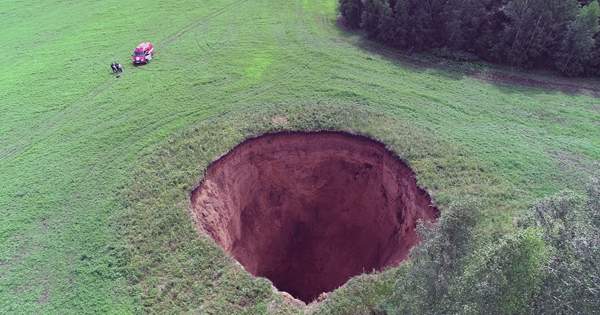In August 2020, the new geological feature was officially monitored by scientists from the Yamal Authority, the RAS Institute on Oil and Gas Problems, and scientists at Skoltech, who are hoping to publish a scientific study of the hole in the near future. The giant hole was spotted in northwestern Siberia earlier this summer on its way to an unrelated office by a TV crew helicopter.
Hundreds of meters of rock and mud scattered across the Yamal Peninsula have exploded into an open hole after an explosive bubble of methane gas exploded beneath the soil of remote Siberian tundra.
“The hole is fresh; it appeared in the central part of Yamal this year, its diameter exceeds 20 meters, and its depth is more than 30 meters,” Evgeny Chuvilin, a leading research scientist at the Skoltech Center for Hydrocarbon Recovery who surveyed the hole, told IFLScience. “More detailed information will be published in more scientific articles in the near future.”
In the end, the gas reservoirs create enough pressure, and the next thing you know – kaboom! – A hole is formed. Occasionally, this methane can get trapped under the soil, which at the same time becomes unstable from molten permafrost.
As the temperature warms and the ice permafrost begins to melt, bacteria and other germs re-emerge and begin pumping methane in damp and low oxygen conditions. Plenty of craters are the result of permafrost which is declining due to rising temperatures in the region. Permafrost is rocky soil or silt that is usually frozen year-round and contains huge stores of organic carbon and frozen microorganisms.
This process not only leaves behind these huge marks on the ground, but it also increases the risk of flooding the atmosphere with more greenhouse gases and further drives the cycle of climate change. It is also worth noting that methane is a particularly powerful greenhouse gas and has significantly “warming power” compared to carbon dioxide.
In the past when craters of the same type were formed, locals heard a loud noise and even saw smoke and flame billowing. Unfortunately, scientists have not yet been able to effectively observe this explosive process. “They are still forming in remote and uninhabited places,” Chuvilin added. “But if these changes happen, they could pose an infrastructural threat.”
Chuvilin explained that there is currently “limited evidence” that the new hole was created due to warmer temperatures, but this is not something that researchers would be interested in investigating, as this summer saw some unusually warm weather in Siberia. Researchers have previously linked the formation of some grooves to warmer temperatures in Siberia. For example, some scientists speculated that the Yamal Crater was formed in 2014 after a scorching heat in 2012.
The most dramatic example of the geological turmoil from the permafrost flowing as a 1 km long (0.62 mile) slash in the landscape of the Sakha Republic is seen in the Batagaika mega rush, known as the “gateway to the underworld” in the eastern depths of Russia, Siberia.
Temperatures in the Siberian city of Verkhoyansk above the Arctic Circle reached a staggering 38 degrees Celsius (100.4 F). Although this scorching hot summer has not yet been clearly linked to climate change, it is clear that much of the Arctic is currently warming much faster than other parts of the planet due to an event called the Arctic Expansion, Back in June.














